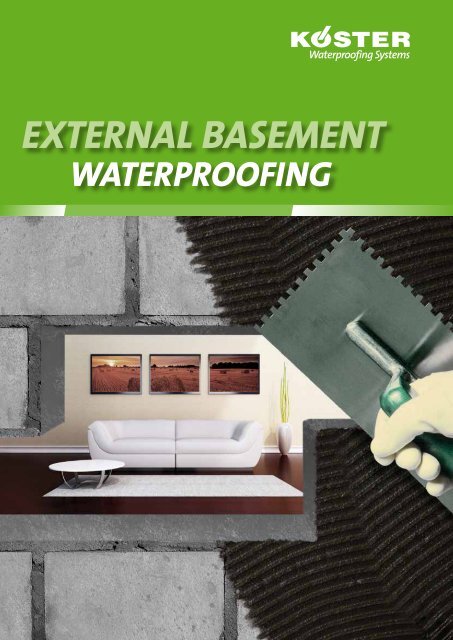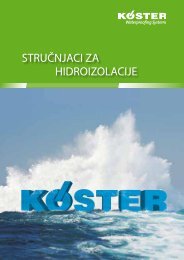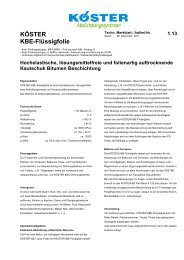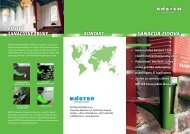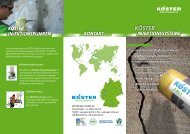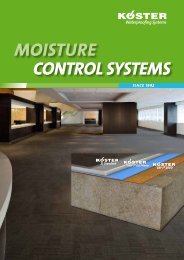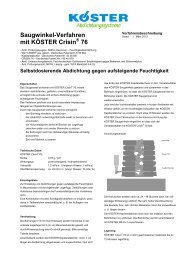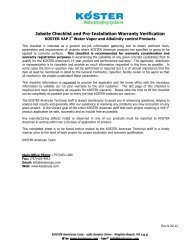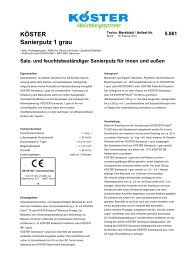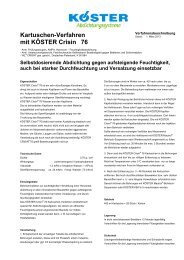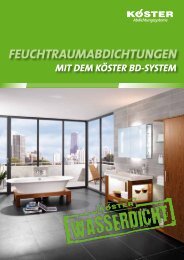External Basement Waterproofing - Koester.eu
External Basement Waterproofing - Koester.eu
External Basement Waterproofing - Koester.eu
Create successful ePaper yourself
Turn your PDF publications into a flip-book with our unique Google optimized e-Paper software.
external <strong>Basement</strong><br />
waterproofing
Content<br />
<strong>External</strong> basement waterproofing<br />
Content 2<br />
<strong>External</strong> <strong>Basement</strong> <strong>Waterproofing</strong> 3<br />
What is positive side waterproofing? 3<br />
KÖSTER <strong>Waterproofing</strong> Solutions<br />
The KÖSTER solutions for positive side waterproofing 4<br />
KÖSTER Rubberized Bitumen Thick Films 6<br />
Cementitious, crystallizing waterproofing system: KÖSTER NB 1 Grey 8<br />
Crack bridging cementitious coating: KÖSTER NB Elastic 10<br />
The less space that there is available in metropolitan<br />
regions, the more construction is done<br />
below grade. <strong>Basement</strong>s are used as inexpensive<br />
living and storage rooms and parking space is<br />
moved underneath apartment or commercial<br />
Platzhalter<br />
buildings. Many cities are located close to rivers<br />
or the sea. Very often the ground water table is<br />
high and waterproofing of below grade / below<br />
water table building elements is essential for the<br />
usability of these structures.<br />
Introduction<br />
Cold self adhesive membrane: KÖSTER KSK membrane 12<br />
A special solution in repair cases: Curtain injection with KÖSTER PUR Gel 14<br />
<strong>Waterproofing</strong> of joints 14<br />
Application<br />
Surface preparation 15<br />
Below grade waterproofing is the core discipline<br />
of any waterproofing specialist. About 80%<br />
of the damages in construction are directly or<br />
indirectly linked to problems caused by moisture.<br />
In contrast a reliable protection against<br />
moisture can typically be achieved for less than<br />
5% of the total construction cost. <strong>Waterproofing</strong><br />
does not only protect buildings but investments.<br />
That is why a high quality waterproofing is so<br />
important.<br />
Cleaning the surface 15<br />
Leveling the surface 15<br />
What is positive side waterproofing?<br />
Priming the surface 16<br />
Installing fillets 17<br />
Protection of the waterproofing layer 18<br />
<strong>External</strong> basement waterproofing is a so called<br />
positive side waterproofing, which means that<br />
the waterproofing material is applied to that<br />
side of the construction which is or will be in<br />
direct contact with water. An example would be<br />
the positive side waterproofing applied to the<br />
outside of a basement wall or on the inside of a<br />
tank.<br />
Quality control 19<br />
Weather conditions during application 19<br />
<strong>External</strong> basement waterproofing<br />
reinforced concrete floor<br />
Good to know<br />
How to waterproof a concrete slab 20<br />
How to waterproof pipe penetrations 20<br />
How to waterproof pile heads 21<br />
Time and costs of waterproofing 21<br />
What does „crack bridging” mean? 22<br />
KÖSTER product range 23<br />
waterproofing layer<br />
fillet<br />
reinforced concrete walls<br />
reinforced concrete<br />
foundation plate<br />
protection layer<br />
(approx. 5 cm unreinforced concrete)<br />
Contact 24<br />
The information contained in this brochure are non-binding and do not release the applicator from his responsibility for the correct application under consideration of the<br />
specific conditions of the construction site and for the final results of the construction process. The valid standards for testing and installation, acknowledged rules of technology<br />
as well as our technical guidelines have to be adhered to at all times.<br />
waterproofing layer<br />
blinding layer (approx. 5 cm unreinforced concrete)<br />
<strong>External</strong> basement waterproofing 2 | 3
The KÖSTER solutions for positive side waterproofing<br />
For each case the best solution: A number of factors influence the selection of a waterproofing<br />
system, such as characteristics and condition of the substrate, the construction site, and the environmental<br />
conditions. A waterproofing material must be suitable for the substrate and be able to<br />
withstand the load condition which it will be exposed to. If a substrate is in danger of cracking, the<br />
waterproofing material must have crack bridging properties. If the substrate is wet, only materials<br />
can be used that can tolerate wet substrates. The following table will give an overview of the<br />
range of waterproofing materials which KÖSTER provides.<br />
Product name KÖSTER D<strong>eu</strong>xan® 2C KÖSTER D<strong>eu</strong>xan® Professional KÖSTER NB 1 Grey / NB 2 White Product name KÖSTER NB Elastic Grey / White KÖSTER KSK SY 15<br />
Material class rubberized bitumen thick film rubberized bitumen thick film cementitious crystallizing slurry Material class elastic cementitious coating cold self-adhesive membrane<br />
Temperature range for application +5 °C to +35 °C +5 °C to +35 °C +5 °C to +30 °C Temperature range for application +5 °C to +35 °C +5 °C to +35 °C<br />
Consumption approx. 4 - 6 kg / m² 4 - 6 kg / m² 2 - 4 kg / m² Consumption approx. 3.6 - 4.5 kg / m² 1.10 m² / m²<br />
Layers 2 + primer 2 + primer 2 / no primer (W) Layers 2 / no primer (W) 1 + primer<br />
Colour black black grey / white Colour light grey / white black<br />
Solvent-free yes yes yes Solvent-free yes yes<br />
Certification for potable water - - yes Certification for potable water - -<br />
Can be plastered over - - ++ Can be plastered over + -<br />
Crystallizing properties, penetrates into substrate no no yes Crystallizing properties, penetrates into substrate no no<br />
Mode of application trowelable sprayable brushable / sprayable Mode of application brushable / sprayable hand-application<br />
Suitable for negative side waterproofing as so called "sandwich-waterproofing" as so called "sandwich-waterproofing" yes Suitable for negative side waterproofing as so called "sandwich-waterproofing" as so called "sandwich-waterproofing"<br />
Waiting time until backfilling > 24 hours > 24 hours > 48 hours Waiting time until backfilling > 48 hours no waiting time<br />
Price per m² *2 ** ** * Price per m² 2* ** *<br />
Cost of application per m² ** * *** manual / * spray application Cost of application per m² *** manual / * spray application **<br />
Simplicity of application ++ ++ ++ Simplicity of application ++ +<br />
Substrate<br />
Introduction<br />
Masonry ++ ++ ++ Masonry ++ ++<br />
Cementitious plaster ++ ++ ++ Cementitious plaster ++ ++<br />
Concrete ++ ++ ++ Concrete ++ ++<br />
Polystyrene ++ + not suitable Polystyrene + +<br />
Old bitumen membranes / coats ++ + not suitable Old bitumen membranes / coats not suitable ++<br />
Moisture condition of the surface dry or slightly damp dry or slightly damp dry or wet Moisture condition of the surface dry or wet dry<br />
Performance<br />
Performance<br />
Waterproof against max. load condition pressurized water pressurized water pressurized water Waterproof against max. load condition pressurized water pressurized water<br />
Time until rainproof approx. 8 h / 1* approx. 8 h / 1* approx. 8 h Time until rainproof approx. 8 h immediately<br />
Chemical resistance good good good Chemical resistance good good<br />
Tested to be radon proof yes yes - Tested to be radon proof - / yes yes<br />
Permeability to vapor diffusion low low high Permeability to vapor diffusion medium very low<br />
UV-resistance not long term resistant not long term resistant long term resistant UV-resistance long term resistant not long term resistant<br />
Abrasion resistance - - ++ Abrasion resistance + -<br />
Crack bridging ++ ++ - Crack bridging ++ ++<br />
Embedding of a mesh possible possible - Embedding of a mesh possible -<br />
1* The final layer of polymer modified bitumen thick film sealants can be made rainproof by spraying KÖSTER BE Rainproof onto the fresh coating W Wetting is sufficient (substrate should be moist). In case of highly absorbent substrates prime with KÖSTER Polysil® TG 500.<br />
2* lower * medium ** higher ***<br />
Rubberized bitumen thick films:<br />
KÖSTER D<strong>eu</strong>xan® 2C and<br />
D<strong>eu</strong>xan® Professional<br />
• easy and seamless application, even on moist<br />
surfaces, crack bridging<br />
• suitable for large and small areas even with<br />
many details<br />
• low requirements on the substrate<br />
Crystallizing waterproofing system:<br />
KÖSTER NB 1 Grey<br />
• cementitious, crystallizing waterproofing<br />
• penetrates into the surface and becomes<br />
integral part of it<br />
• also for negative side waterproofing<br />
• wear resistant<br />
• self-healing properties<br />
Crack bridging cementitious<br />
waterproofing: KÖSTER NB Elastic<br />
• crack bridging<br />
• easy and seamless application, excellent in<br />
combination with KÖSTER NB 1 Grey<br />
• even on areas which are exposed to sunlight<br />
• resistant to foot traffic<br />
Cold self adhesive membranes:<br />
KÖSTER KSK AW 15 / KÖSTER KSK SY 15<br />
• fast, reliable, with uniform layer thickness<br />
• crack bridging even at very low temperatures<br />
• excellent for waterproofing of concrete slabs<br />
• large areas can be waterproofed quickly<br />
• no drying time<br />
<strong>External</strong> basement waterproofing 4 | 5
Rubberized Bitumen Thick Films<br />
Advantages<br />
Application of KÖSTER D<strong>eu</strong>xan® 2C<br />
The KÖSTER D<strong>eu</strong>xan® bucket has an insert which<br />
contains a bag with the powder component.<br />
The powder component is slowly mixed into<br />
the bitumen component using a slow rotating<br />
stirring device. Mixing time is 3 minutes.<br />
The first layer of KÖSTER D<strong>eu</strong>xan® is applied,<br />
in this case by trowel. Surface profiles and<br />
unevenness up to a depth of max. 5 mm are filled<br />
with a scraped layer of KÖSTER D<strong>eu</strong>xan® 2C.<br />
<strong>Waterproofing</strong> Solutions<br />
• crack-bridging up to 2 mm<br />
• easy to apply<br />
• no joints - seamless application<br />
• according to DIN 18195<br />
• easy control of the layer thickness<br />
• easy leveling of uneven substrates<br />
• low demands on safety<br />
compared to hot bitumen<br />
• reinforcing mesh can be embedded<br />
Description<br />
KÖSTER D<strong>eu</strong>xan® is a fiber reinforced, twocomponent<br />
waterproofing compound consisting<br />
of a rubberized bitumen emulsion with<br />
additives. No special tools are necessary for<br />
application as opposed to the application of<br />
hot bitumen. Application is easy even in detail,<br />
e.g. around pipe penetrations, inner and outer<br />
corners, wall-floor junctions, etc. Complies with<br />
the DIN 18 195 (German standard for external<br />
basement waterproofing).<br />
KÖSTER Glas Fibre Mesh is embedded into the<br />
first fresh layer of KÖSTER D<strong>eu</strong>xan®. Generally, a<br />
mesh has to be embedded in areas which are in<br />
danger of cracking. When waterproofing against<br />
pressurized water, KÖSTER Glass Fibre Mesh has<br />
to be embedded in the whole area.<br />
The second layer of D<strong>eu</strong>xan® is applied shortly<br />
after the first layer of KÖSTER D<strong>eu</strong>xan®.<br />
In case of pressurized water the second layer is<br />
not applied before the first layer has fully cured.<br />
We recommend applying a sample of the material<br />
with linearly changing thickness to a brick and to<br />
store that brick on the construction site. The wedge<br />
can then be cut to check how far it has cured in<br />
different depths.<br />
Spray application - KÖSTER D<strong>eu</strong>xan® Professional<br />
KÖSTER D<strong>eu</strong>xan® Professional is similar to<br />
KÖSTER D<strong>eu</strong>xan® 2C but specifically designed<br />
for spray application with a suitable spraying<br />
device. Spray application provides a very<br />
high productivity which makes it attractiv for<br />
professional contractors and for larger objects. It<br />
requires knowledge of the pump and the spraying<br />
process. The spraying equipment has to be<br />
tested and fine tuned before commencing work.<br />
<strong>External</strong> basement waterproofing 6 | 7
Cementitious, crystallizing waterproofing system:<br />
KÖSTER NB 1 Grey<br />
Description<br />
KÖSTER NB 1 Grey contains active ingredients<br />
which penetrate into the substrate, crystallize, and<br />
thereby create an insoluble barrier which will retain<br />
its function as long as the substrate itself remains<br />
sound. Because of its penetrating and<br />
crystallizing properties, KÖSTER NB 1 Grey can<br />
successfully be used on both the inside and the<br />
outside (positive and negative side waterproofing) of<br />
structures with equally good results. A white version,<br />
KÖSTER NB 2 White, is also available.<br />
Application<br />
One bag (25 kg) of KÖSTER NB 1 Grey is mixed<br />
with 8 l of water. The water is placed in a mixing<br />
container of sufficient size.<br />
Alternatively one bag can be mixed with:<br />
- 8 l of KÖSTER NB 1 Flex or<br />
- 6 l water + 2 kg KÖSTER SB-Bonding Emulsion<br />
Both additives raise the ability of KÖSTER NB 1<br />
Grey to retain water and lead to a plastification<br />
of the material.<br />
<strong>Waterproofing</strong> Solutions<br />
By adding 20% KÖSTER SB Bonding Emulsion to the<br />
mixing water, the bonding of KÖSTER NB 1 Grey and<br />
flexibility are improved. This also has a positive effect<br />
on curing, since it protects the fresh coating from<br />
drying out too fast.<br />
The active ingredients of KÖSTER NB 1 Grey lead to a<br />
waterproofing crystallization in mineral substrates,<br />
also in case of high moisture contents in the wall.<br />
KÖSTER NB 1 Grey does not contain any corrosion<br />
promoting ingredients which can negatively affect<br />
the reinforcement steel.<br />
Advantages<br />
• penetrates into the substrate and<br />
creates a chemical and mechanical<br />
bond that will last as long as<br />
the wall itself<br />
• crystallizing waterproofing system<br />
Description • suitable for drinking water<br />
applications<br />
• abrasion resistant<br />
• for mineral substrates such as<br />
concrete and brick walls<br />
• open to water vapor diffusion<br />
• self healing properties: contains<br />
permanently active ingredients<br />
which can seal subsequent micro<br />
cracks<br />
• suitable for moist surfaces<br />
• easy to apply<br />
• fast<br />
• safe<br />
• no joints<br />
• also suitable for negative side<br />
waterproofing<br />
The powder is added in portions while continually<br />
mixing using a slowly rotating electrical mixer<br />
with a suitable mixing paddle. Mixing time is<br />
3 minutes.<br />
KÖSTER NB 1 Grey<br />
Concrete<br />
Fillet<br />
KÖSTER NB 1 Grey is applied using a coarse brush.<br />
Make sure to brush up and down as well as<br />
left and right in order to close all pinholes.<br />
<strong>External</strong> basement waterproofing 8 | 9
Crack bridging cementitious coating: KÖSTER NB Elastic<br />
Application<br />
Pour the liquid component completely into a<br />
clean mixing container.<br />
The powder component is slowly mixed into the<br />
liquid component in portions using an electrical<br />
mixer. Mixing time is 3 minutes.<br />
<strong>Waterproofing</strong> Solutions<br />
Advantages<br />
• for mineral substrates such as<br />
concrete and brick walls<br />
• crack bridging up to 2 mm<br />
• resistant to foot traffic<br />
• ideal for balconies and terraces<br />
• suitable for moist surfaces<br />
• easy to apply<br />
• fast<br />
• safe<br />
• no joints<br />
• open to water vapor diffusion<br />
• together with NB 1 Grey suitable<br />
for negative side waterproofing<br />
• cement based system<br />
• ideal in combination with KÖSTER NB 1<br />
Grey, e.g. on wallfloor junctions,<br />
corners etc. where crack bridging is<br />
required<br />
Application of the first layer of KÖSTER NB<br />
Elastic grey to the wall with brush or trowel.<br />
KÖSTER Flex Fabric is embedded in the first layer.<br />
Description<br />
KÖSTER NB Elastic is an elastic and wear-resistant<br />
coating which can bridge cracks of up to 2 mm.<br />
The material is available in white or grey.<br />
KÖSTER NB Elastic is widely used on concrete<br />
or masonry surfaces. Ideal in combination<br />
with KÖSTER NB 1 Grey in all areas where crack<br />
bridging is required. Excellent for waterproofing<br />
terraces and balconies.<br />
Application of the second layer of KÖSTER NB<br />
Elastic grey.<br />
<strong>External</strong> basement waterproofing 10 | 11
Cold self adhesive membrane: KÖSTER KSK membrane<br />
Application<br />
After priming the substrate, fillets are installed<br />
at the wall-floor junction.<br />
Fillets can be made of either KÖSTER Repair<br />
Mortar or alternatively with the cold selfadhesive<br />
KÖSTER KSK Triangular Ribbon.<br />
<strong>Waterproofing</strong> Solutions<br />
Advantages<br />
• cold-applied, self-adhesive<br />
• no hot-air or propane-flame<br />
welding necessary<br />
• uniform waterproofing layer<br />
• one layer solution<br />
• immediate waterproofing effect /<br />
no drying time<br />
• great flexibility<br />
• fast application due to 1.05 m<br />
membrane width<br />
• universally applicable<br />
• crack-bridging<br />
• solvent-free<br />
• laminated on the top side<br />
with a highly tear-resistant foil,<br />
thus highly resistant against<br />
perforation<br />
• highly resistant to aging<br />
• self-sealing in case of small<br />
damages<br />
• high seam resistance against<br />
water pressure and water vapor<br />
After that, the membrane is applied to inside<br />
and outside corners.<br />
The area is waterproofed with the membrane.<br />
Membranes must overlap by approx. 10 cm.<br />
Description<br />
KÖSTER KSK membrane is a cold self-adhesive<br />
rubber bitumen waterproofing membranes with<br />
a double laminated, highly tear resistant polyethylene<br />
foil on top. It's highly flexible, immediately<br />
waterproof, crack-bridging and resistant to driving<br />
rain. The waterproofing membrane is suitable for<br />
the waterproofing of basements and basement<br />
slabs. For application between +5 °C and +35 °C use<br />
KÖSTER KSK SY 15.<br />
Use a roller to firmly press the membranes onto<br />
the substrate.<br />
The edges of the membrane are sealed with KÖSTER<br />
KBE Liquid Film.<br />
If no separate base waterproofing is installed, the<br />
upper edge of the waterproofing layer has to end<br />
approx. 30 cm above grade. In order to achieve<br />
an attractive visual appearance, the upper edge<br />
of the membrane can be covered with the cold<br />
self-adhesive KÖSTER Butyl Fix-Tape Fleece. This<br />
tape can be plastered over.<br />
Finished waterproofing with KÖSTER KSK<br />
<strong>External</strong> basement waterproofing 12 | 13
A special solution for repair cases:<br />
Curtain injection with KÖSTER PUR Gel<br />
Surface preparation<br />
All surfaces have to be prepared before they<br />
receive a waterproofing layer. In most cases the<br />
substrate preparation determines the quality of<br />
the system. Surface preparation in waterproofing<br />
can not be overestimated. Usually the<br />
surface has to be taken off or cleaned until a<br />
solid substrate is reached, leveled and primed.<br />
The substrate has to be sound, solid, free of<br />
bonding inhibiting agents such as grease and oil,<br />
separating substances and loose parts. In corners<br />
concave fillets have to be installed.<br />
In repair cases<br />
If the substrate is cracked, the cracks can be<br />
injected with KÖSTER Injection systems as<br />
outlined in the KÖSTER brochure “Crack Repair<br />
and Crack Injection Systems”. Moving joints have<br />
to be waterproofed separately, e.g. using KÖSTER<br />
Joint Tape or KÖSTER Joint Sealant FS. Active<br />
leakages have to be stopped before any area<br />
waterproofing can be applied.<br />
For cementitious waterproofing it is necessary<br />
to remove old existing coatings as well as soil<br />
or residues from the building process such as<br />
cement lime on the surface of the concrete.<br />
Application<br />
In cases where an existing basement is leaking<br />
and the soil surrounding the building cannot<br />
be excavated, the waterproofing has to be done<br />
from the inside. With KÖSTER PUR Gel it is possible<br />
to create an exterior waterproofing layer<br />
by injecting through the wall from the inside into<br />
the surrounding soil, (curtain injection). KÖSTER<br />
PUR Gel reacts with the mixing water to form an<br />
elastic, crack bridging waterproofing layer.<br />
Cleaning the surface<br />
All coating residues, form work release oil and<br />
any other contaminants which might adversely<br />
affect the bonding have to be removed. The<br />
surface must be stripped down to its base<br />
structure, (removal of residues and<br />
efflorescence). Depending on the case high<br />
pressure water jetting or sandblasting may be<br />
required.<br />
<strong>Waterproofing</strong> of joints<br />
Cold-, expansion-, and construction joints are<br />
necessary to permit movement in a building.<br />
Sealing joints in construction elements means to<br />
seal them permanently, elastically, form stable<br />
and UV- resistant. This allows future movements<br />
of the construction member without causing any<br />
damage. Normal Construction joints up to 35 mm<br />
can be sealed with KÖSTER Joint Sealant FS. For<br />
wider joints (like dilation joints) we recommend<br />
KÖSTER Joint Tapes.<br />
Levelling the surface<br />
On mineral substrates, holes smaller than 5 mm<br />
can be closed e. g. using KÖSTER NB 1 Grey. When<br />
using KÖSTER D<strong>eu</strong>xan® as area waterproofing<br />
material, irregularities in the substrate can be<br />
levelled by applying a scraped layer before the<br />
waterproofing layers.<br />
All holes wider or deeper than 5 mm have to be<br />
filled using KÖSTER Repair Mortar. Gravel nests,<br />
break outs, construction joints and other areas<br />
which are susceptible to leaking or which are<br />
difficult to coat must be opened up and filled<br />
with KÖSTER Repair Mortar.<br />
<strong>External</strong> basement waterproofing 14 | 15
Priming the surface<br />
Installing fillets with KÖSTER Repair Mortar<br />
The main objective of a primer is to facilitate<br />
bonding between the substrate and the<br />
waterproofing layer. Without primer, a<br />
waterproofing layer may separate from the<br />
substrate. Therefore, in many cases the primer is<br />
an essential part of the waterproofing system.<br />
For cementitious waterproofing materials like<br />
KÖSTER NB 1 Grey, a polymer and silicate based<br />
primer (KÖSTER Polysil® TG 500) is used, whereas<br />
for the bituminous waterproofing materials<br />
additional bitumen based primers can be used.<br />
Some primers provide extra value. For example<br />
KÖSTER Polysil® TG 500 hardens the substrate,<br />
reduces the capillary action, and reduces the<br />
movement of salts in the substrate.<br />
The following table shows the different available primers together with their usage.<br />
Many waterproofing defects occur in the wall-floor<br />
junction. There, two areas connect at a 90° angle.<br />
If the connected areas move against each other,<br />
for example due to differing thermal expansion of<br />
the wall and the floor slab, the motion is focused in<br />
that 90° connection causing very high stresses to<br />
the waterproofing layer. In order to allocate these<br />
stresses to a larger surface the wall floor junction<br />
is rounded out by installing a concave fillet. This<br />
reduces the impact on the waterproofing layer<br />
considerably.<br />
To install a fillet, KÖSTER Repair Mortar is the material<br />
of choice. The leg length of the fillet is usually<br />
4–6 cm. A fillet made of KÖSTER Repair Mortar can<br />
be covered with any waterproofing material including<br />
bitumen thick films. Before the installation of a<br />
fillet, prime the substrate with KÖSTER NB 1 Grey.<br />
A concave fillet in the wall-floor junction with<br />
KÖSTER Repair Mortar<br />
Application<br />
<strong>Waterproofing</strong> Material KÖSTER D<strong>eu</strong>xan® 2C /<br />
KÖSTER D<strong>eu</strong>xan® 2C /<br />
KÖSTER NB 1 / NB 2<br />
KÖSTER NB 1 / NB 2<br />
<strong>Waterproofing</strong> Material KÖSTER KSK SY 15 KÖSTER KSK SY 15 KÖSTER KSK SY 15<br />
Professional<br />
Professional<br />
KÖSTER NB Elastic Grey<br />
/ White<br />
KÖSTER NB Elastic Grey<br />
/ White<br />
Primer KÖSTER Polysil® TG 500 KÖSTER Bitumen Primer KÖSTER Polysil® TG 500 Prewetting Primer KÖSTER KSK Primer SP KÖSTER KBE Liquid Film KÖSTER KSK Primer BL<br />
Basis polymer silicate based bitumen polymer silicate based water Basis polymer resin, contains solvents highly flexible, polymer<br />
modified bitumen emulsion<br />
polymer modified<br />
bitumen emulsion<br />
Temperature range +2°C to +30°C +2°C to +30°C > + 5 °C > + 5 °C Temperature range -10 °C to +30 °C + 5 °C to +35 °C +5 °C<br />
Consumption approx. 100 - 250 g / m² 150 - 200 ml / m² 100 - 250 g / m² to saturation Consumption approx. 100 - 200 ml / m² 250 g / m² 250 - 400 g / m²<br />
Price per m² 1* *** ** *** - Price per m² 1* ** ** *<br />
Substrate<br />
Masonry, low absorbent + + + + Masonry, low absorbent ++ ++ +<br />
Masonry, absorbent ++ + ++ + Masonry, absorbent ++ ++ ++<br />
Masonry, highly absorbent ++ + ++ + + Masonry, highly absorbent ++ + +<br />
Lime cement plaster ++ + ++ - Lime cement plaster + + +<br />
Cementitious plaster ++ + ++ + Cementitious plaster ++ ++ ++<br />
Porous concrete ++ + ++ + + Porous concrete ++ + +<br />
Concrete, low absorbent ++ + ++ + Concrete, low absorbent ++ + +<br />
Concrete, absorbent ++ + ++ + Concrete, absorbent ++ ++ ++<br />
Concrete, highly absorbent ++ + ++ + + Concrete, highly absorbent ++ + ++<br />
Plastics - - - - Plastics no priming no priming no priming<br />
Aluminum - - - - Aluminum no priming no priming no priming<br />
Polystyrene - - - - Polystyrene ++ ++ -<br />
Old bitumen membranes / -coats - ++ - Old bitumen membranes / -coats - - -<br />
1* lower * medium ** higher ***<br />
++ primer is ideally suitable for substrate<br />
+ primer is suitable for substrate<br />
- primer not suitable<br />
<strong>External</strong> basement waterproofing 16 | 17
Protection of the waterproofing layer<br />
Quality control<br />
Back filling of the construction pit and settlement<br />
of the ground over time are frequent sources<br />
of damage to the waterproofing layer. Usually<br />
the material used to backfill the construction<br />
pit does not consist of clean sand but contains<br />
coarse aggregates. During backfilling, these<br />
aggregates can be pushed into the waterproofing<br />
layer and damage it. For this reason the<br />
installation of a protective layer is required.<br />
High quality waterproofing solutions require<br />
high quality application. This must be taken very<br />
seriously. A waterproofing system application is<br />
not complete without quality control. Compared<br />
to the cost of failure during the use of a building,<br />
quality control is a very low cost, high return<br />
measure in construction.<br />
Quality control for waterproofing systems<br />
includes:<br />
• frequent measuring of wet layer thickness<br />
during application<br />
• control of consumption<br />
• optical examination of the surface during and<br />
after application, and during curing of the<br />
material<br />
• testing if the waterproofing layer has fully<br />
cured before backfilling<br />
• measuring the dry layer thickness on a<br />
reference sample stored in the construction pit<br />
• documentation of the work, (written protocol,<br />
photos)<br />
• use of method statements including check lists<br />
for all work steps<br />
Application<br />
KÖSTER SD Sheet 3-400 protects the waterproofing<br />
and provides a drainage for residual water.<br />
XPS boards completely bonded with KÖSTER D<strong>eu</strong>xan®<br />
A good documentation helps the contractors to<br />
improve the quality of their work and reduces<br />
risk. For the owner the documentation is<br />
helpful for future reference and to receive a full<br />
warranty.<br />
Protective layers ideally combine three<br />
functions: mechanical protection, drainage,<br />
and a decoupling or gliding layer. The KÖSTER<br />
SD Sheet 3-400 consists of three layers. The<br />
mechanical protection is provided by the main<br />
layer, a HDPE dimple sheet. Facing the soil, a<br />
fleece is attached to the dimples of the dimple<br />
sheet in order to maintain the drainage<br />
function. The third layer on the backside of the<br />
dimple sheet facing the waterproofing layer is<br />
a LDPE foil.<br />
This gliding layer between dimple sheet and<br />
waterproofing layer prevents damages due to<br />
backfilling or settling of the ground.<br />
Alternatively, other systems like XPS boards,<br />
which provide other benefits such as thermal<br />
insulation, may be used.<br />
On concrete slabs, a protection layer of screed<br />
is often used to prevent mechanical damages<br />
from subsequent building activity.<br />
Weather conditions during application<br />
Here are some important tips regarding weather conditions:<br />
Rain<br />
Rain may wash away liquid<br />
waterproofing materials.<br />
Especially waterproofing materials<br />
that are based on bitumen<br />
emulsions need the evaporation process for<br />
curing and therefore have to be protected from<br />
rain. Application of KÖSTER Rain Proof is one<br />
option. Other liquid products applied have to be<br />
protected from being washed off. KÖSTER KSK<br />
Membranes are rainproof immediately after<br />
application.<br />
Sun<br />
Sun and high temperatures can result<br />
in shorter reaction times of any liquid<br />
waterproofing material and thus<br />
reduces the pot life and the time available<br />
for application. In that case less material is mixed<br />
at once in order to apply the waterproofing before<br />
curing. The sun can also prematurely dry out cementitious<br />
materials so that wetting becomes necessary. It<br />
is always preferable to work in the shade. In extreme<br />
cases the work has to be carried out before sunrise or<br />
after sunset. KÖSTER offers HT (“high temperature”)<br />
versions of several products.<br />
Wind<br />
Wind can increase water<br />
evaporation drastically, especially<br />
in combination with high<br />
temperatures. Cementitious<br />
waterproofing materials need a certain water<br />
/ cement ratio to cure completely. Pre-watering<br />
of the substrate and wetting of the applied<br />
waterproofing material may be necessary.<br />
Strong winds can also cause problems with<br />
spray application.<br />
Frost<br />
By frost a material containing<br />
water such as a bitumen thick film<br />
must not be applied because it will<br />
freeze and thereby be destroyed.<br />
Be careful with any kind of emulsions, sealing<br />
slurries, water based primers, etc. Only when<br />
environmental temperatures are above +5 °C,<br />
the cold self adhesive membrane KÖSTER KSK SY<br />
15, together with the water free primer KÖSTER<br />
KSK Primer SP is the ideal solution.<br />
<strong>External</strong> basement waterproofing 18 | 19
How to waterproof a concrete slab<br />
How to waterproof pile heads<br />
A concrete slab is ideally waterproofed from<br />
underneath: A blinding layer is installed, on top of<br />
it a waterproofing layer, then a gliding layer,<br />
e.g. two layers of polyethylene foil, and finally<br />
a protection layer in order to not destroy the<br />
waterproofing layer with subsequent building<br />
activity.<br />
The three major challenges to waterproofing pile<br />
heads are: Firstly, during the vibration of the concrete<br />
sometimes small gaps between the reinforcement<br />
steel and the concrete are generated. This can<br />
lead to leakages later on. The waterproofing has to<br />
solve this. Secondly, the piles are the foundation of<br />
a building which means the waterproofing on the<br />
pile head has to resist high compression. Thirdly, it is<br />
important to connect the area waterproofing well<br />
to the pile head waterproofing. Here the steps of<br />
waterproofing of a pile head are shown.<br />
Good to know<br />
<strong>Waterproofing</strong> with KÖSTER KSK Membranes<br />
For the waterproofing of a slab cementitious<br />
systems, bituminous liquid applied systems, or<br />
membranes can be used. KÖSTER KSK membranes<br />
have the advantage that one can<br />
<strong>Waterproofing</strong> with KÖSTER D<strong>eu</strong>xan®<br />
immediately continue work after installing the<br />
membrane. In basements it is important to connect<br />
the horizontal and vertical waterproofing,<br />
(floor to wall), completely.<br />
Removing protrusions, cleaning the pile head<br />
Installing a fillet and smoothing the area with<br />
KÖSTER Repair Mortar<br />
How to waterproof pipe penetrations<br />
While a wall area may be easy to waterproof, a<br />
pipe and cable penetration is not. The main<br />
problems that occur with pipe and cable penetrations<br />
are possible movements of the pipes or<br />
cables, and that materials passed through pipe and<br />
cable penetrations have very different characteristics,<br />
(polymers, concrete, metal etc.). The waterproofing<br />
solution has to be plastic, (as opposed to<br />
“elastic”), so that movements can be absorbed and<br />
bonding to a wide variety of materials is possible.<br />
Sometimes a cable may have to be removed or a<br />
new cable routed. The KÖSTER KB-Flex 200 System<br />
provides the solution for this problem even if it is a<br />
repair with active water ingress.<br />
A PU-Foam is injected in order to have a backing for<br />
the KÖSTER KB-Flex 200.<br />
<strong>Waterproofing</strong> of the pile head with<br />
KÖSTER NB 1 Grey<br />
Time and costs of waterproofing<br />
When talking about the cost of waterproofing, it is<br />
important to calculate the total cost involved and<br />
not only the cost per kg of the waterproofing<br />
material. Time is a key factor which influences the<br />
costs of waterproofing. The total time needed for<br />
waterproofing involves the factors surface preparation<br />
time, application time, curing time between the<br />
different work steps, and time for quality control.<br />
Different materials require different surface preparation<br />
which leads to differences in cost. The more<br />
Connection of the area waterproofing<br />
(KÖSTER D<strong>eu</strong>xan®) to the pile head waterproofing<br />
elaborate the surface preparation, the more expensive<br />
it is. Different modes of application require more<br />
or less time. Spray application is faster than manual<br />
application, single layer systems are faster than two<br />
or more layer systems. Hand application may on the<br />
other hand be better to control and therefore more<br />
secure. For smaller areas, manual application with<br />
a trowel or brush is most economical whereas on<br />
bigger areas it may well be worth using spraying<br />
equipment such as the KÖSTER Variojet.<br />
Total application costs<br />
Then KÖSTER KB-Flex 200 is filled into the void using<br />
the KÖSTER Special Caulking Gun.<br />
The pipe penetration is now waterproof. In order to<br />
protect the waterproofing the area around the pipe or<br />
cable is plugged with KÖSTER KB-Fix 5.<br />
Preparation of<br />
construction site<br />
Surface preparation<br />
Priming<br />
<strong>Waterproofing</strong> Material<br />
Application of waterproofing<br />
material<br />
Quality control<br />
<strong>External</strong> basement waterproofing 20 | 21
What does “crack bridging” mean?<br />
KÖSTER Product Range<br />
Crack bridging waterproofing means that the<br />
waterproofing system remains intact even<br />
though the substrate has cracked. Often, “crack<br />
bridging” is confused with “elastic”. A material<br />
may be elastic but not waterproof when<br />
stretched. It may also be waterproof at first but<br />
not able to withstand water pressure.<br />
Corners and pipe penetrations are among the<br />
areas which are considered to be at high risk of<br />
cracking. When a substrate cracks, the flanks of<br />
the crack move against each other, thus stressing<br />
the elastic waterproofing which was applied to<br />
the substrate. Even elastic waterproofing materials<br />
can reach the limits of their elasticity if the<br />
crack width becomes too great or crack movement<br />
is frequent enough. Therefore it makes<br />
sense to take preventive measures in such areas<br />
to avoid damage to the waterproofing. When<br />
using liquid applied waterproofing materials,<br />
KÖSTER Glass Fibre Mesh can be embedded into<br />
the first fresh layer of the waterproofing. This<br />
ensures that the waterproofing layer is not damaged<br />
even if the substrate cracks. If the substrate<br />
cracks, the mesh will keep the waterproofing<br />
layer over the crack from tearing.<br />
1 <strong>External</strong> basement waterproofing<br />
2 Internal basement waterproofing<br />
3 Horizontal barriers/<br />
Restoration of masonry<br />
4 Crack and hose injection<br />
5 Concrete protection and repair<br />
6 Sealing of expansion joints<br />
7 Bathroom and wet room waterproofing<br />
8 Mould control<br />
9 Floor coatings<br />
10 Façade protection<br />
11 Balcony and terrace waterproofing<br />
12 Roof waterproofing<br />
13 Water tank and reservoir waterproofing<br />
Good to know<br />
10<br />
12<br />
7<br />
8<br />
11<br />
1. Elastic but not crack bridging: The waterproofing layer does not withstand the permanent<br />
water pressure.<br />
1<br />
5<br />
4<br />
6<br />
13<br />
2<br />
9<br />
3<br />
2. Crack bridging waterproofing: In this case due to elasticity and layer thickness. The waterproofing<br />
layer withstands permanent water pressure.<br />
3. Crack bridging due to an embedded mesh. The mesh separates the top waterproofing layer from<br />
the crack and helps significantly to withstand permanent water pressure.<br />
KÖSTER BAUCHEMIE AG develops, produces, and supplies a comprehensive range of special<br />
construction materials in the areas of water-proofing and concrete repair. Founded in 1982 in<br />
Germany, the KÖSTER Group consists meanwhile of 24 companies which are represented in more<br />
than 50 countries. It is our policy to offer construction materials of the highest quality, durability<br />
and general performance.<br />
<strong>External</strong> basement waterproofing 22 | 23
Service you can depend on<br />
With our service and distribution network in many<br />
countries world-wide we can offer you<br />
professional advice and technical support<br />
immediately and on the spot. Your<br />
required waterproofing materials can<br />
be delivered promptly and will protect<br />
your property efficiently and lastingly.<br />
For further information, please contact:<br />
KÖSTER BAUCHEMIE AG | Dieselstraße 1–10 | D-26607 Aurich | Germany<br />
Phone: +49 (4941) 9709-0 | Fax: +49 (4941) 9709-40 | info@koster.<strong>eu</strong> | www.koster.<strong>eu</strong>


